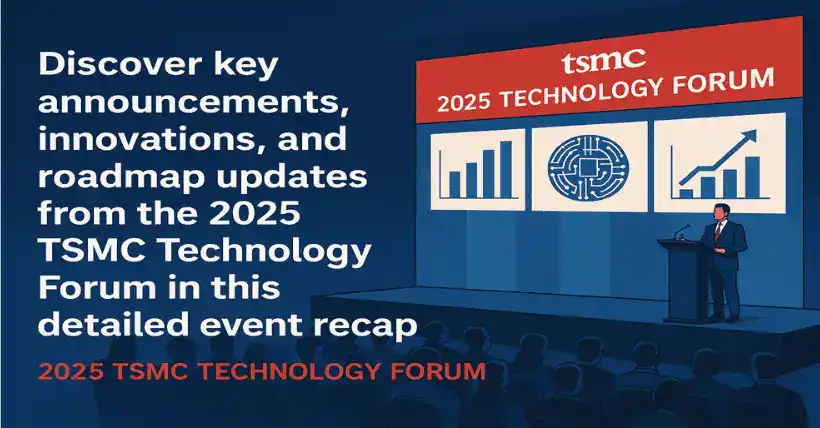I. Overall Strategic Positioning: The AI-Driven New Era of Semiconductors
1.1 Core Insight: AI is Expanding from the Cloud to the Edge
AI was initially concentrated in data centers, such as for GPT model training.
TSMC points out: AI will be ubiquitous (edge AI, end devices, autonomous driving, robotics, etc.).
Driving rapid growth in wafer demand for high-performance computing (HPC), smartphones, automotive electronics, and IoT.
1.2 Market Forecast (by 2030):
Global semiconductor market size will reach USD 1 trillion
Breakdown:
- HPC & AI: 45%
- Smartphones: 25%
- Automotive electronics: 15%
- IoT: 10%
- Others: 5%
II. TSMC Advanced Process Technology Roadmap
2.1 A14 Node (Mass Production Expected in 2028)
Technical Features:
- 2nd generation nanosheet transistors
- Shrinking pitch (tighter layout, improved PPA)
- Innovative device architecture + nano-flex technology (boosts performance and power efficiency)
Expected Outcomes:
- Development ahead of schedule, yield meets standards
- Super power rail version (2029): further enhances power delivery
2.2 A16 Node (Mass Production Expected in 2026)
Technical Features:
- Uses Super Power Rail (SPR)
- Backside power delivery: reduces IR drop, increases density
- Optimized for data center/HPC applications
2.3 N2 Series (Mass Production Starts in H2 2025)
- N2: First mass production node adopting nanosheet structure at scale
- 256Mb SRAM average yield over 90%
- Suitable for energy-efficient computing and mobile devices
- N2P (H2 2026): more power-efficient and higher performance than N2
- N2X (2027): designed for ultimate performance, ~10% frequency boost
Customer Adoption:
- HPC/AI adoption accelerating, 2nd-year NTO count ~4x that of N5
2.4 N3 Series: The Peak and Conclusion of FinFET Technology
- N3E: Already in mass production with good yield, used for flagship phones, HPC, AI
- N3P (Mass Production Q4 2024): successor to N3E
- N3X: tailored for high-frequency CPUs
- N3A: automotive-grade
- N3C: entry-level products
- N3 series is the final FinFET family, with a long lifecycle and broad applicability
III. Advanced Packaging and System Integration Technologies (3DFabric®)
3.1 3D Packaging Family (TSMC – SoIC®, CoWoS®, InFO®)
- SoIC®: 3D chip stacking technology to enhance performance and bandwidth
- N3 stacked with N4 (6μm pitch) → mass production in 2025
- A14 stacked with N2 → mass production in 2029
- Already in mass production since 2022
Future:
- CoWoS® / InFO®: ideal for high-bandwidth memory (HBM) and logic chip integration
- SoW (System on Wafer):
- Wafer-level system integration (SoW-X tech expected 2027)
- For high-speed AI transmission and compute-intensive logic (e.g., H100, B200 AI chip architectures)
IV. Power Supply and System Energy Efficiency
4.1 Integrated Power Solutions (Dedicated for AI)
- AI power consumption is rising rapidly, compute units reaching kilowatt (kW) levels
- TSMC proposes single-chip PMIC + inductor solution, with 5x power density of traditional PCBs
- eDTC/DTC tech in CoWoS-L: aids filtering and stabilizes power supply
V. Support for Emerging Applications: AR and Robotics
- AR/VR devices require “lightweight and efficient” design; TSMC offers high-density system integration platforms
- Future humanoid robots will demand ultra-high-density chips
- TSMC invests in high-density power delivery, high-speed computing, and integrated AI accelerators and memory
Summary: TSMC Technology Evolution Roadmap (2024–2030)
| Year | Process Node & Packaging | Application Areas |
|---|---|---|
| 2024 | N3P, CoWoS-L, power filtering | Smartphones, HPC, AI |
| 2025 | N2, SoIC N3 stacked with N4 | Data centers, Edge AI |
| 2026 | N2P, A16 | Higher chip density, backside power |
| 2027 | N2X, SoW-X | High-performance AI integration systems |
| 2028 | A14 | New architecture + nano-flex transistors |
| 2029 | A14 Super Rail Version, SoIC A14 stacked with N2 | Ultimate AI chip integration |
| 2030 | Wafer-level system, mature high-density power delivery | Humanoid robots, AR |

Disclaimer:
- This channel does not make any representations or warranties regarding the availability, accuracy, timeliness, effectiveness, or completeness of any information posted. It hereby disclaims any liability or consequences arising from the use of the information.
- This channel is non-commercial and non-profit. The re-posted content does not signify endorsement of its views or responsibility for its authenticity. It does not intend to constitute any other guidance. This channel is not liable for any inaccuracies or errors in the re-posted or published information, directly or indirectly.
- Some data, materials, text, images, etc., used in this channel are sourced from the internet, and all reposts are duly credited to their sources. If you discover any work that infringes on your intellectual property rights or personal legal interests, please contact us, and we will promptly modify or remove it.



